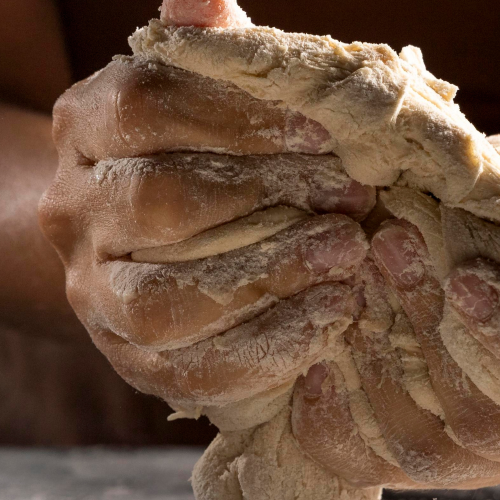Method:
Activate the Yeast:
In a small bowl, combine the lukewarm water and active dry yeast. Stir gently and let it sit for about 5-10 minutes until it becomes frothy, indicating the yeast is active.
Combine Ingredients:
In a large mixing bowl, combine the bread flour and salt. Create a well in the center and pour in the yeast mixture. Using a wooden spoon or your hands, mix until a shaggy dough forms.
Knead the Dough:
Transfer the dough onto a lightly floured surface. Knead for about 10 minutes until it becomes smooth and elastic. If the dough is too sticky, sprinkle a little more flour; if too dry, add a few drops of water.
First Rise:
Shape the dough into a ball and place it in a lightly oiled bowl, turning to coat all sides. Cover with a damp cloth or plastic wrap and let it rise in a warm, draft-free area for about 1 to 1.5 hours, or until doubled in size.
Shape the Loaf:
Gently punch down the risen dough to release air. Transfer it to a floured surface and shape it into a round or oval loaf, tucking the edges underneath to create surface tension.
Second Rise:
Place the shaped loaf onto a parchment-lined baking sheet or into a proofing basket seam-side up. Cover and let it rise for another 30-45 minutes until slightly puffed.
Preheat the Oven:
About 30 minutes before baking, preheat your oven to 220°C (430°F). If using a baking stone or Dutch oven, place it in the oven to heat up.
Score and Bake:
If the loaf is on a baking sheet, gently turn it onto the sheet seam-side down. Using a sharp blade or lame, score the top of the loaf with a few slashes to allow for expansion. Transfer the loaf (with parchment if using) into the preheated Dutch oven or onto the baking stone. Cover if using a Dutch oven.
Bake for 20 minutes, then remove the cover (if applicable) and reduce the oven temperature to 200°C (390°F). Continue baking for an additional 20-25 minutes until the crust is deep golden brown and the loaf sounds hollow when tapped on the bottom.
Cool:
Carefully remove the bread from the oven and let it cool on a wire rack for at least 1 hour before slicing. This ensures the interior sets properly.
Variations and Tips:
Whole Wheat Version: Substitute up to 50% of the bread flour with whole wheat flour for a denser, more flavorful loaf.
Herb-Infused Bread: Add 1-2 tablespoons of chopped fresh rosemary or thyme to the dry ingredients for an aromatic twist.
Olive and Sun-Dried Tomato Addition: Incorporate chopped olives or sun-dried tomatoes into the dough during the initial mixing for added texture and flavor.
Dietary Substitutions:
Gluten-Free: Use a gluten-free bread flour blend and ensure all other ingredients are certified gluten-free. Note that the texture may differ from traditional rustic bread.
Low-Sodium: Reduce the salt by half or use a salt substitute suitable for baking.
